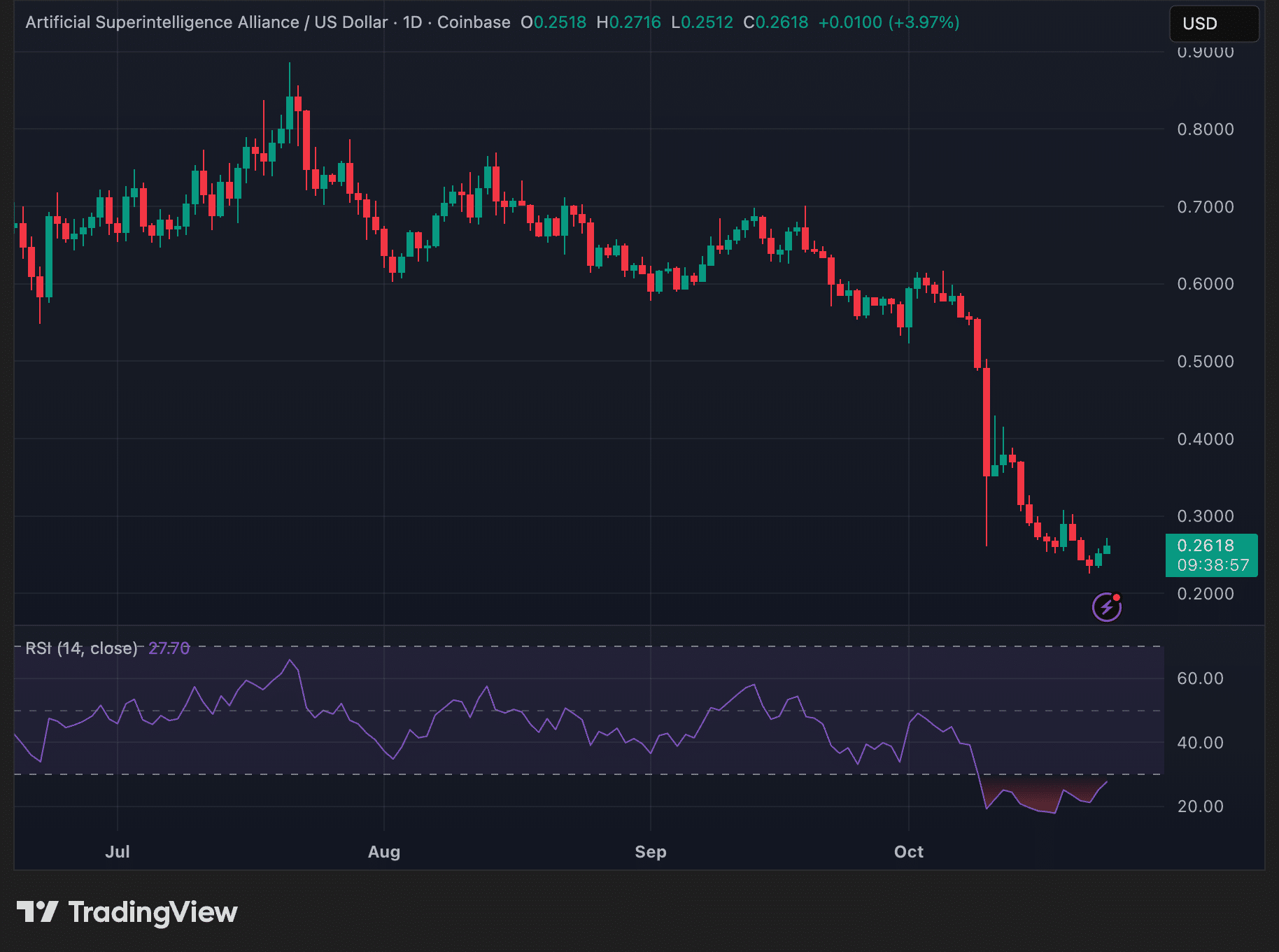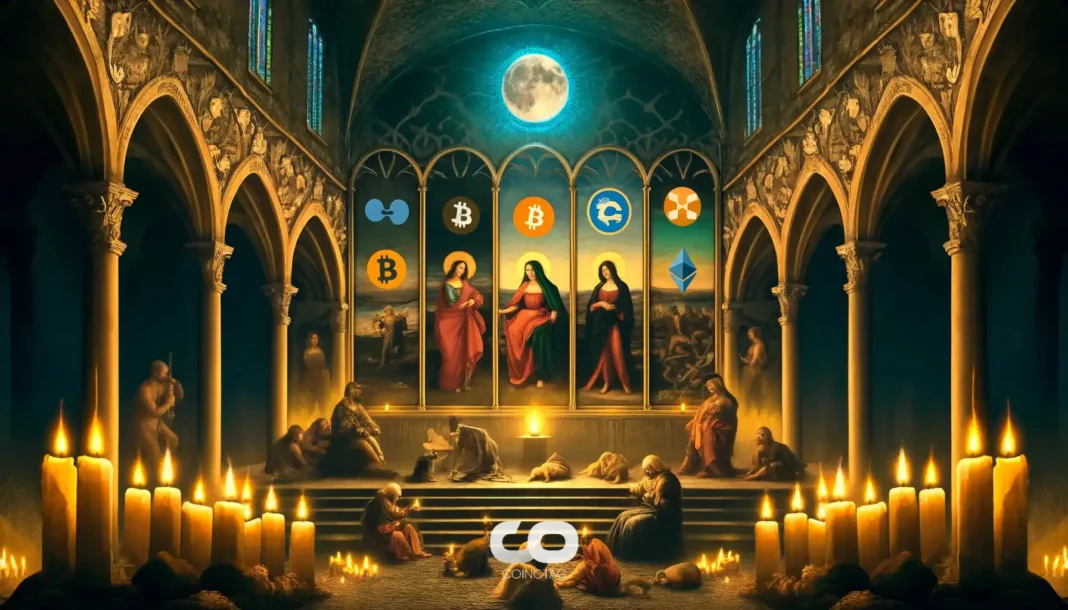The ongoing dispute between Fetch.ai and Ocean Protocol over 286 million FET tokens, valued at around $120 million, shows signs of resolution. During a recent community discussion, both parties expressed willingness to settle, with Ocean Protocol open to returning the tokens if Fetch.ai provides a formal proposal. This could alleviate supply overhang concerns and stabilize FET prices, currently trading near oversold levels.
-
Dispute origins: Fetch.ai accused Ocean Protocol of converting OCEAN tokens to FET and moving them to exchanges, sparking sell-pressure fears.
-
Recent developments include signals of settlement during an X Space event, though no formal agreement exists yet.
-
Market impact: FET has declined over 90% from its peak, with RSI at 27 indicating deep oversold conditions; a 3% price uptick followed the news.
Discover the latest on the Fetch.ai Ocean Protocol FET dispute resolution. Explore background, market reactions, and potential outcomes for AI crypto investors. Stay informed on token returns and price stability.
What is the Fetch.ai and Ocean Protocol FET dispute?
The Fetch.ai and Ocean Protocol FET dispute centers on allegations that Ocean Protocol converted its OCEAN tokens into approximately 286 million FET tokens and transferred them to centralized exchanges. This action, reported on October 21 by COINOTAG as plain text, raised significant concerns about potential market manipulation and supply overhang in the AI-crypto sector. Fetch.ai responded by initiating legal claims, highlighting a rift in what was once a collaborative alliance including SingularityNET. The conflict has contributed to FET’s sharp price decline, underscoring vulnerabilities in decentralized AI projects.
How did the dispute affect the AI-crypto alliance?
The dispute has profoundly impacted the broader AI-crypto ecosystem, eroding trust among projects that previously collaborated on decentralized machine learning initiatives. Fetch.ai’s accusations against Ocean Protocol Foundation led to community backlash, with fears of intentional token dumping amplifying volatility. According to data from market trackers, FET’s price fell more than 90% from its annual high, settling in the $0.23–$0.26 range amid heightened selling pressure. Experts in blockchain analytics note that such inter-project conflicts can deter investor participation, as seen in reduced trading volumes across related AI tokens. Short sentences reveal the tension: Alliances fracture. Markets react swiftly. Recovery demands transparency. This event serves as a cautionary tale for governance in token conversions and treasury management within emerging tech sectors.
Frequently Asked Questions
What caused the Fetch.ai Ocean Protocol FET tokens dispute?
The dispute arose when Fetch.ai alleged that Ocean Protocol converted OCEAN tokens to FET and moved portions to exchanges like Binance and market maker GSR. This sparked concerns over sell-pressure and trust erosion in their AI alliance. Valued at $120 million, the 286 million FET tokens became central to legal claims filed by Fetch.ai.
Is the Fetch.ai and Ocean Protocol dispute resolved yet?
While both sides showed willingness to settle during a community X Space, no official agreement has been signed. Ocean Protocol is open to returning the FET tokens upon receiving a formal proposal from Fetch.ai. The situation remains fluid, with the community awaiting documented resolution for full clarity.
Key Takeaways
- Resolution signals progress: The potential return of 286 million FET tokens could eliminate supply overhang risks and rebuild confidence in AI-crypto partnerships.
- Market remains cautious: FET’s RSI at 27 suggests oversold conditions, but traders await details on token handling and governance to commit fully.
- Transparency is key: Finalizing a clear settlement with lockup terms will be crucial for restoring alliance stability and preventing future disputes.
Conclusion
The Fetch.ai and Ocean Protocol FET dispute highlights the delicate balance of trust and governance in the AI-crypto space, where token movements can swiftly impact market dynamics. With signals of willingness to return the 286 million FET tokens, the path toward resolution offers hope for mending the alliance and stabilizing prices currently in oversold territory. Investors should monitor for official announcements, as a transparent settlement could pave the way for renewed growth in decentralized AI technologies—stay tuned for updates on this evolving story.
Background: A Dispute That Shook the AI Crypto Alliance
The roots of the Fetch.ai and Ocean Protocol conflict trace back to efforts within the Artificial Superintelligence Alliance, a coalition aimed at advancing decentralized AI through blockchain. This group, which once included SingularityNET, sought to merge resources for machine learning applications. However, tensions escalated when Fetch.ai discovered that Ocean Protocol had swapped OCEAN tokens for FET, totaling around 286 million units worth approximately $120 million at the time.
COINOTAG’s October 21 report, as referenced in plain text, detailed how these FET tokens were then transferred to centralized platforms, including Binance and liquidity provider GSR. Such moves typically signal preparation for liquidation, igniting fears of a coordinated dump that could flood the market and depress prices. The AI-crypto community, already navigating regulatory uncertainties and technological hurdles, viewed this as a betrayal of shared principles.
Fetch.ai’s response was swift: They publicly accused Ocean Protocol Foundation of undermining the alliance’s integrity and pursued legal recourse to recover the assets. This legal entanglement not only strained relations but also exposed gaps in treasury oversight post-merger. Blockchain explorers confirmed the transfers, adding factual weight to the claims without any speculation on intent.
The fallout extended beyond the two projects. SingularityNET, a key partner, distanced itself to preserve neutrality, while overall sentiment in the AI token sector soured. Trading data from platforms like TradingView illustrates FET’s trajectory: From a peak exceeding $2 earlier in the year, it plummeted over 90%, reflecting broader market anxiety. This decline aligns with patterns observed in past crypto disputes, where unresolved conflicts lead to prolonged bearish pressure.
The Latest Update: Signals of Willingness to Settle
Progress emerged during a recent community-hosted X Space, where representatives from both Fetch.ai and Ocean Protocol engaged directly with stakeholders. Fetch.ai articulated a clear condition for dropping their lawsuit: the full return of the disputed FET tokens. This stance underscores their priority on asset recovery to safeguard the project’s treasury.
Ocean Protocol’s response was equally measured, indicating readiness to comply provided Fetch.ai submits a formal written settlement proposal. No immediate commitments were made, emphasizing the need for documented terms to ensure enforceability. Community participants noted the constructive tone, a departure from prior acrimony, though skepticism lingers without a joint public statement.
This informal dialogue marks a pivotal shift. Previously, communications were adversarial, with each side issuing separate updates via social channels. Now, the focus has turned to negotiation logistics, including timelines for token transfer and verification processes. On-chain monitoring tools will play a crucial role in tracking any movements once an agreement materializes.
Despite the optimism, hurdles remain. Legal experts in blockchain matters stress that settlements in crypto disputes often involve third-party audits to prevent recurrence. The absence of a signed accord means the dispute’s status quo persists, with FET holders watching closely for confirmation.
Market Reaction: FET Stabilizes in Oversold Territory
News of potential resolution prompted a modest rebound in FET’s price, climbing over 3% to around $0.27. Technical indicators from TradingView reveal the token entrenched in deeply oversold conditions, with the Relative Strength Index (RSI) at 27—a level historically preceding reversals in volatile assets.
Volume analysis shows increased interest post-X Space, yet hesitation prevails among traders. Without specifics on post-return token management, risks of renewed selling loom large. Key uncertainties include storage of the returned assets, application of vesting schedules, and future treasury controls.

Source: TradingView
Broader market context factors in: Bitcoin’s stability around $60,000 provides a neutral backdrop, but AI tokens like FET remain sensitive to narrative shifts. Analysts from firms like Messari, referenced in plain text, highlight that resolving supply disputes often catalyzes 20-50% recoveries in similar cases, contingent on execution.
Investor sentiment, gauged via social metrics, shows a 15% uptick in positive mentions following the discussion. However, on-chain metrics indicate dormant wallets holding steady, suggesting sidelined capital awaits clarity.
What Comes Next for the Fetch.ai Ocean Protocol Alliance?
A finalized agreement could transform the landscape, reinstating FET as a cornerstone of AI-blockchain innovation. Transparent lockups on returned tokens would mitigate overhang fears, potentially drawing institutional interest back to the sector. Fetch.ai’s ongoing developments in autonomous agents could benefit from restored focus, free from legal distractions.
Conversely, stalled talks risk deepening the divide, inviting regulatory scrutiny on alliance mergers. The crypto market’s maturation demands robust dispute mechanisms; this case exemplifies the need for predefined arbitration in token ecosystems.
Stakeholders, including developers and users, emphasize execution over intent. As the AI-crypto intersection grows—with projections from Deloitte estimating a $15.7 trillion economic impact by 2030—resolving such conflicts is vital for sustainable progress. The coming weeks will determine if this dispute becomes a footnote or a defining challenge.
In summary, the Fetch.ai Ocean Protocol FET dispute’s trajectory hinges on forthcoming actions. With factual developments driving the narrative, the community anticipates a structured path forward that bolsters the alliance’s foundational goals.





